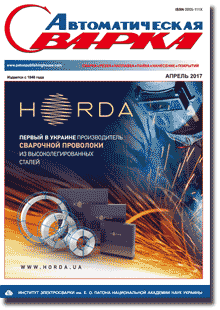| 2017 №04 (10) |
DOI of Article 10.15407/as2017.04.01 |
2017 №04 (02) |

Avtomaticheskaya Svarka (Automatic Welding), #4, 2017, pp. 5-10
Influence of metal structure of pipes on mechanical properties of flash-butt welded joints
S.I. Kuchuk-Yatsenko, B.I. Kazymov And V.F. Zagadarchuk
E.O. Paton Electric Welding Institute, NASU 11 Kazimir Malevich Str., 03680, Kiev, Ukraine. E-mail: office@paton.kiev.ua
Abstract
Technology of flash-butt welding occupies a sufficient place in different industries, including welding of different purpose pipes. At a high quality of joints the discrepancies in values of properties are observed in a number of cases. The paper considers the causes of such discrepancies and their relationship with the initial structure of metal of pipes. It was revealed that the formation of areas with a structural heterogeneity in joints is predetermined by the structure and volume of segregation bands of nonmetallic inclusions in steel and is not related to the technological parameters of welding. In welding of advanced pipe steels, produced by a controllable rolling, the required mechanical properties of the joints are provided. 10 Ref., 1 Table, 8 Figures.
Keywords: pipelines, flash-butt welding, quality of joints, nondestructive testing, standards, mechanical tests, bending tests, delaminations, cracks, nonmetallic inclusions, segregation bands, structural heterogeneity, rejection criteria
Received: 23.02.17
Published: 17.04.17
References
- (1999) API Standard 1104: Welding of pipelines and related facilities ASME boiler and pressure vessel. 19 ed.
- Kuchuk-Yatsenko, S.I. (1992) Flash-butt welding. Kiev: Naukova Dumka.
- Mazur, I.I., Serafin, O.M., Karpenko, M.P. (1988) Resistance welding of pipelines: ways of improvement. Stroitelstvo Truboprovodov, 4, 8–11.
- VSN 006–89: Departmental building specifications. Construction of main and industrial pipelines. Welding: 1989-07–01, Minneftegazstroj.
- GOST 6996–66: Welded joints. Methods of determination of mechanical properties. Moscow: Standart.
- Kuchuk-Yatsenko, S.I. et al. (1980) Plasticity of pipe steel joints in resistance butt welding. Svarka, 2, 1–8.
- Kuchuk-Yatsenko, S.I., Shvets, Yu.V., Shvets, V.I. (2014) Influence of non-metallic inclusions in pipe steels of strength class X65–X80 on values of impact toughness of flash-butt welded joints. The Paton Welding J., 12, 2–7. https://doi.org/10.15407/tpwj2014.12.01
- Dunkerton, S.B. (1986) Toughness properties of friction welds in steels. Research Suppl. to the Welding J., 8, 193-s–202-s.
- Kuchuk-Yatsenko, S.I., Shvets, V.I., Didkovsky, A.V. et al. (2013) Defects of joints of high-strength rails produced using flash-butt welding. The Paton Welding J., 9, 2–8.
- Kuchuk-Yatsenko, S.I. et al. (1984) Formation of dead spot in resistance butt welded joints. Svarka, 11, 23–26.
